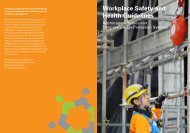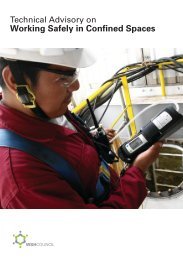here - Workplace Safety and Health Council
here - Workplace Safety and Health Council
here - Workplace Safety and Health Council
Create successful ePaper yourself
Turn your PDF publications into a flip-book with our unique Google optimized e-Paper software.
4 STRATEGIC STRIDES<br />
Spotlight<br />
ON SAFETY<br />
WSH STATISTICS REPORT 2012<br />
HIGH-RISK SECTORS STILL A CAUSE FOR CONCERN<br />
OTHERS<br />
Manufacturing Marine<br />
Construction<br />
79% 21%<br />
A lesson on safety<br />
SAFETY PROFILE 5<br />
from the London Olympics<br />
FATALITY RATE per 100,000 employed persons<br />
4.9<br />
2004<br />
Released by the Ministry of Manpower (MOM), <strong>Workplace</strong> <strong>Safety</strong><br />
<strong>and</strong> <strong>Health</strong> (WSH) <strong>Council</strong> <strong>and</strong> WSH Institute, the latest WSH Statistics<br />
Report shows that the workplace fatality rate has declined to a<br />
record low, from 4.9 per 100,000 employed persons in 2004 to 2.1<br />
per 100,000 employed persons in 2012. However, the number of<br />
reported work injuries <strong>and</strong> incidences of occupational diseases (ODs)<br />
has increased.<br />
HEIGHTENED MONITORING AND EARLY DETECTION IN<br />
OD CASES<br />
839<br />
CASES<br />
2 0 1 1<br />
2012<br />
18 % 88 %<br />
987<br />
CASES<br />
2 0 1 2<br />
Noise–induced<br />
deafness<br />
987<br />
CASES<br />
OD cases rose by 18%—from 839 reported in 2011 to 987 cases<br />
in 2012. This rise was primarily attributed to increased monitoring<br />
efforts by MOM’s Occupational <strong>Safety</strong> <strong>and</strong> <strong>Health</strong> specialists who<br />
encouraged early detection <strong>and</strong> reporting. Of the 987 OD cases, 88%<br />
were cases of noise-induced deafness, with over 98% of workers<br />
diagnosed at the early stage when intervention measures can be<br />
taken to prevent further deterioration.<br />
2012 2011<br />
<strong>Workplace</strong> Injuries 11,113 10,121<br />
Fatal Injuries 56 61<br />
Major Injuries 588 556<br />
Minor Injuries 10,469 9,504<br />
Occupational Diseases 987 839<br />
2.1<br />
2012<br />
Table 1: Number of <strong>Workplace</strong> Injuries <strong>and</strong> Occupational Diseases, 2011 <strong>and</strong> 2012.<br />
The three traditional sectors (manufacturing, marine <strong>and</strong> construction)<br />
continue to account for 79% of workplace fatalities in 2012. These sectors<br />
also saw a collective increase of 17% in both major <strong>and</strong> minor injuries.<br />
Together, all three sectors account for close to half of all major <strong>and</strong> minor<br />
injuries reported in 2012.<br />
Industry 2012 2011<br />
All sectors 56 (55) 61(58)<br />
Construction 26 (25) 22 (21)<br />
Marine 6 (6) 10 (8)<br />
Manufacturing 12 (12) 13 (13)<br />
Logistics & Transport 7 6<br />
Others 5 10<br />
Table 2: Number of <strong>Workplace</strong> Fatal Injuries by Industry, 2011 <strong>and</strong> 2012<br />
Figures in parenthesis refer to the number of fatal incidents.<br />
In particular, the construction sector accounted for nearly half of all work<br />
fatalities (46%) <strong>and</strong> 1 in 4 of major industries. The sector’s fatalities also<br />
rose from 22 in 2011 to 26 in 2012, <strong>and</strong> posted the highest fatal injury<br />
rate amongst the three sectors.<br />
WORK-RELATED FALLS ON THE WATCH LIST<br />
The number of work-related falls fell from 26 cases in 2011 to 17 in 2012.<br />
However, it was still the leading incident type in 2012, accounting for<br />
30% of all fatalities. Fall-related deaths <strong>and</strong> injuries were seen across<br />
both traditional sectors <strong>and</strong> service sectors such as logistics <strong>and</strong> transport,<br />
telecommunications, advertising <strong>and</strong> business support activities.<br />
BUILDING A ROBUST WSH CULTURE WITH CULTURESAFE<br />
Highlighting the need for concrete measures <strong>and</strong> attitudes, Chairman<br />
of the WSH <strong>Council</strong>, Mr Lee Tzu Yang, said, “Industry players need<br />
to review the trends <strong>and</strong> compare them against their workplaces<br />
to identify areas of concern. W<strong>here</strong> shortfalls are seen, companies<br />
must take concrete measures to implement better WSH practices.<br />
To do so, they can tap on various case studies, guidelines <strong>and</strong> codes<br />
of practice issued by the WSH <strong>Council</strong>. But beyond this, we must<br />
change attitudes <strong>and</strong> encourage safe work behaviour. In this aspect,<br />
the <strong>Council</strong>’s CultureSAFE programme can help.”<br />
The CultureSAFE programme, consisting of a five-step CultureSAFE<br />
cycle, has been developed to help organisations nurture a strong<br />
WSH culture <strong>and</strong> inculcate the right WSH mindset among the<br />
workforce. Small- <strong>and</strong> medium-sized enterprises keen to start <strong>and</strong><br />
maintain their safety culture within their workplaces can also tap on<br />
the WSH Culture Fund to help defray the associated costs in adopting<br />
the CultureSAFE programme.<br />
To view the WSH Statistics Report 2012 in full or to find out more about the CultureSAFE programme,<br />
visit www.wshc.sg<br />
The health <strong>and</strong> safety of workers has always been the<br />
priority for the Olympic Delivery Authority (ODA). In this<br />
issue of SHINE, Mr Lawrence Waterman (Order of the<br />
British Empire), Head of <strong>Health</strong> <strong>and</strong> <strong>Safety</strong> for the ODA<br />
<strong>and</strong> Past President of Institution of Occupational <strong>Safety</strong><br />
<strong>and</strong> <strong>Health</strong>, shares with us his experience in constructing<br />
one of the biggest <strong>and</strong> most challenging projects the<br />
United Kingdom (UK) has ever undertaken – London<br />
Olympics 2012.<br />
When the UK began construction work for London Olympics 2012, it<br />
was calculated that the project would see three deaths, more than<br />
500 workers would be seriously injured <strong>and</strong> around 100 of them<br />
would have their lives adversely affected by their injuries. However,<br />
the London Olympic facilities turned out to be the first in the history of<br />
the Games to be completed without a fatality.<br />
The Olympic Park built for the London Olympics was a massive project.<br />
Construction for the Olympic facilities involved the 80,000-seater<br />
Stratford Stadium <strong>and</strong> 2,818 flats for the Olympic Village.<br />
CAREFUL PLANNING AT EVERY STEP<br />
Planning was done based on simple foundations that can be applied<br />
to building projects of any size <strong>and</strong> place:<br />
• Show commitment to safety<br />
ODA showed its commitment to safety by declaring a zerofatality<br />
target. With measurable objectives <strong>and</strong> targets, ODA sent<br />
out a clear message on what all workers were expected to work<br />
towards. Leadership was also provided at every level, from the<br />
Chief Executive to every subcontractor to get everyone to work<br />
to prevent deaths onsite.<br />
• Design for safety <strong>and</strong> health<br />
ODA encouraged designers to design for health <strong>and</strong> safety in<br />
construction, use <strong>and</strong> future maintenance.<br />
• Detailed planning <strong>and</strong> risk management<br />
ODA planned every phase of work, profiled every risk <strong>and</strong><br />
managed those risks carefully.<br />
ODA’s determination <strong>and</strong> attention to planning <strong>and</strong> risk<br />
management paid off. After 62 million man-hours, the London<br />
Olympic facilities were the first in the history of the Games to be<br />
completed without a fatality. Its onsite accident frequency rate<br />
is less than the all-industry average of 0.21 <strong>and</strong> from a worker’s<br />
perspective, working at the site of the London Olympics was<br />
equivalent to working in an office.<br />
HEALTH AND WELL-BEING AS CRITICAL AS ACCIDENT<br />
PREVENTION<br />
Research has shown that more construction workers have their<br />
health damaged than t<strong>here</strong> are those who are injured in accidents<br />
during work. This was verified from what they observed during the<br />
construction of the Olympic Park.<br />
They found that an overwhelming number of the 12,000 builders<br />
had an unhealthy lifestyle <strong>and</strong> many were significantly overweight.<br />
Workers often skipped their breakfasts after indulging in fatty<br />
takeaways the night before <strong>and</strong> in the one-hour period before lunch,<br />
their minds were usually on what they wanted for lunch rather<br />
than on the job at h<strong>and</strong>. This distraction was the main reason why<br />
accidents happen. To keep safety on top of the workers’ minds, ODA<br />
offered healthy porridge to them for just £1. The result was — better<br />
diets, lower accident rates <strong>and</strong> a general boost to health.<br />
LEARNING LEGACY<br />
All these efforts had helped ODA reap rewards of a more efficient<br />
<strong>and</strong> effective workforce. The approach ODA has adopted is relevant<br />
not only for the construction sector, but also for any workplace.<br />
The construction of Singapore’s venues <strong>and</strong> public infrastructure<br />
<strong>and</strong> London Olympic Park are intimately connected. The initiatives<br />
that worked for the Olympic Park can also be applied elsew<strong>here</strong>.<br />
Many of the safety procedures at the Olympic Park were not new<br />
but they were implemented consistently <strong>and</strong> thoroughly. Daily<br />
activity briefings were m<strong>and</strong>ated, even at the smallest site. Onsite<br />
communication, no matter how trivial, was also strongly encouraged.<br />
With visible commitment throughout any project, every organisation<br />
can protect their workers <strong>and</strong> bring success to their business.

















